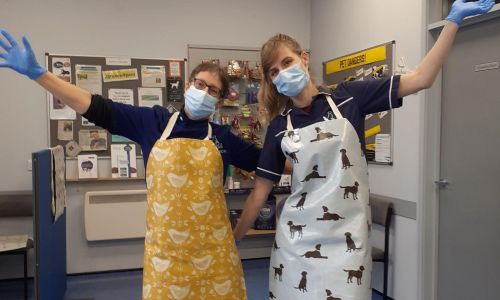Greener Veterinary Practice Checklist
The Vet Sustain Greener Veterinary Practice Checklist outlines where to start and provides links to available guidance and green-options.
The Vet Sustain Greener Veterinary Practice Checklist outlines the points a veterinary practice may consider to become more sustainable, and provides links to available guidance and green options.
This Checklist has been created by Vet Sustain in partnership with BVA, BVNA and SPVS. On this page you can find the full Checklist together with links to useful resources and our independent recommendations, and a free download of the poster for your practice.

Download the poster for your practice below

1. Practise Responsible Resource Use
a) Reduce fossil fuel use for energy and heating by remembering to turn appliances off and switching to renewable energy:
- Use resources from The Carbon Trust to reduce practice energy use
- Switch to green energy provider, using a green energy comparison site to investigate such as Green Energy Switch or Big Clean Switch
b) Segregate and dispose of waste appropriately, reducing, reusing, and recycling where possible:
- Perform a waste audit
- Segregate waste to reduce the volume of incinerated clinical waste. Did you know that proper segregation of your clinical waste can reduce emissions from high-temperature incineration and save money? Some useful resources include the BVA Handling veterinary waste guidance posters and this In Practice article on How to manage healthcare waste and reduce its environmental impact
- Recycle material where possible
- Make sure the whole team is aware of what can be recycled. Some useful resources can be found at Wrap, Recycle Now and Terracycle
- Switch from single-use plastics bins. Use reusable sharps bins such as these from Sharpsmart and Stericycle or cardboard-based pharmaceuticals bins such as bio-bins or 4G Safe bins.
c) Reduce disposable materials usage, including single-use plastics, where possible:
- Use reusable cloth surgical hats such as these from All Scrubbed Up
- Replace shoe covers with theatre shoes
- Use reusable cloth hand towels and re-sterilise them, if using traditional scrub techniques
- Use reusable textile surgical drapes and gowns, when suitable
- Use reusable sterilisation wraps or tins, such as these from B.Braun Vet Care, IMS or Veterinary Instrumentation
- Use recyclable sterilisation pouches, such as these from Millpledge Veterinary
- Replace purified water bottles with a water purifier
d) Ensure responsible paper sourcing, use and disposal:
- This VetTalk article on Sustainable Paper Usage in Veterinary Practice and these "How to" guides from the NHS Sustainable Development Unit are useful resources
e) Put water-saving measures in place:
- Use alcohol-based surgical skin preparation versus traditional surgical scrub
- Install a cistern displacement device in your loo to save 1 litre per flush!
- Rationalise dishwasher loading and running
- Use fleece animal bedding that is easier to wash and line dry
f) Make sustainable choices when purchasing equipment or consumables
- Follow these 10 tips for sustainable procurement
- Encourage your suppliers to minimise packaging
- Purchase supplies from companies with environmental credentials

2. Be sustainable in your operation
a) Include eco-principles in building design or adaptations where possible:
- For example, integrate energy saving features such as those in the Advanced Energy Design Guide series
b) Ensure environmental legislation compliance:
- For example, make sure you are correctly handling veterinary waste by following the BVA guidance posters
c) Use evidence-based infection control measures and minimise use of ecotoxic chemicals:
- Get tips from this article on How to implement an infection control strategy
d) Minimise the greenhouse gas impacts of anaesthetic agents:
- For example, avoid nitrous oxide, choose anaesthetic protocols carefully and use lower-flow techniques. For more information, read this article on reducing anaesthetic gas for environmental benefit
e) Enhance on-site green spaces and promote biodiversity in surroundings:
- Plant trees at your vet practice. Read Vet Sustain’s Planting trees at your veterinary practice Part One and Part two from VetOffset
- Join the Bee Friendly Practice Scheme
f) Promote animal welfare:
- Take a look at the BVA animal welfare strategy
Consider practice commitments in areas such as reduced-stress handling and hospitalisation, support for ethical decision-making, use of pain scoring tools and neutering kittens at four months old. Get inspired by the PDSA's approach to advancing animal welfare in their Pet Hospitals using a pet wellbeing task force, practice-based champions and clinical audit.
g) Support sustainable welfare-friendly agriculture when advising farming clients:
- Read the BVA position on Farm assurance schemes and the BVA position on sustainable animal agriculture
h) Create a travel-policy to reduce emissions from business travel, commuting and freight:
- Read the Vet Sustain article from Investors in the Environment on Getting to grips with Travel Planning
i) Support walking, cycling or public transport use, by staff and clients:
- The UK Government provides guidance for employers who want to put in place a cycle to work scheme
- Cycling UK provides simple and useful cycle maintenance guides
j) Reduce carbon emissions from conferencing, education and practice meetings:
- Attend some conferences or CPD virtually where possible
- Consider holding your practice meetings between branches as a teleconference
k) Utilise paper-free management systems wherever possible.

3. Use medicines responsibly
a) Practise responsible antimicrobial stewardship (including antiparasitic) to mitigate resistance:
- Read the BVA responsible use of antimicrobials in veterinary practice 7-point plan
- Display the BVA responsible use of anthelmintics in grazing animals poster
- Display the BVA "Are you antibiotic aware?" poster for practices
b) Avoid drug wastage through good stocking principles
c) Dispose of drugs correctly (avoid ecotoxicity)

4. Empower the team
a) Support staff wellbeing and development, eg through sustainability education and projects, and encourage formation of a ‘Green group’
b) Recognise that good health and wellbeing supports all aspects of practice operations. This includes physical, emotional, psychological, and social wellbeing:
If you can take these steps and note your improvements, you’re ready to write your Sustainability policy for your practice.
- Create a “Green group” of passionate team members
- Communicate what you are doing with your clients



